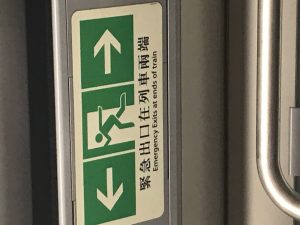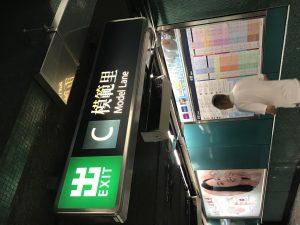Hong Kong is a modernized city with multilingual communities and diverse groups of people. It is clear already that Hong Kong is “modernized,” judging by its advanced economy, developed infrastructure, and tracking with the mainstream trends. However, the city is also “modern” in terms of its extensive use of languages “not widely spoken by the local populace,” which is English. The big factor that could have contributed to Hong Kong becoming a multilingual and modernized location is its past history as a British colony. There are many places named after British elements, such as Victoria Peak, Victoria Harbour, and Victoria Prison, all named after Queen Victoria. After the U.K government restored Hong Kong to China, English continued to be used. Putting infrastructural and economic development aside, Hong Kong is a modernized, cosmopolitan city because it demonstrates the usage of multiple languages visually and orally due to its historical status as a British colony.
According to Leeman and Modan, the wide use of English in Hong Kong demonstrates that Hong Kong became very cosmopolitan. In the city, English is a language that is commonly used in public visually and orally. In terms of the visual aspect, the language is commonly used to guide people when navigating. For example, the city has many signs in the streets that are written in not only traditional Chinese but also English as well. As shown in Figure 1, the instruction is written in both languages. The same goes for Figure 2, where both the traditional Chinese and English words are naming the place Exit C leads to. The oral aspect is interesting. Hong Kong is, without a doubt, multilingual in this part as much as it is visually, as mentioned before. However, it is still quite different. The local people do not speak traditional Chinese; they use Cantonese, which is another spoken dialect used (besides Mandarin) to pronounce traditional Chinese characters. On top of that, some of them are also familiar with speaking Mandarin as well, which makes Hong Kong an even more multilingual city; Cantonese, English, and Mandarin are the three most used languages in the community. And although Cantonese is the most commonly used language, it is still very likely for the local people to understand some English and Mandarin if a foreigner were to interact with them. Also, the language is not area-dependent. Most neighborhoods demonstrate familiarity with the different languages. So as a whole city, Hong Kong is a very melded multilingual community that opens foreigners to being capable of communicating with the local people in some way.
The answer to why Hong Kong is such a multilingual city today lies in its past as a British colony. The British empire ruled Hong Kong for 156 years, transforming it into one of its most valuable ports for sea and air trade, particularly Victoria Harbour. After being under the western influence for so long, Hong Kong saw little changes since 1997, when the British handed sovereignty back to China. “English continues to be the language of success in business and government.” According to statistics, Hong Kong’s expatriate community continues to be three percent of the population, living financially well and not learning Chinese. So despite being free from the British ruling, Hong Kong did not undergo drastic changes and in fact incorporated the western influence in its culture.
The word “modern” means more than just being mainstream, well developed, and being current. For a city, it also means being globalized to the extent foreign languages become common to use in the area. English, over the past century, has without a doubt become a globalized standard language that is very useful for navigating in the world. Hong Kong not only uses Cantonese as its native language but also English as well. Many of the local people know enough of it to communicate with foreigners. The major factor to this is Hong Kong’s role as a British colony for over a century when western influence transformed the city’s linguistics forever. Today, Hong Kong is considered a modernized city, characterized by its usage of multiple languages and inclusion of different kinds of people.

Interesting essay! The way that Hong Kong’s history and development has influenced it’s current culture and how both Cantonese and English are used on fairly equal levels enough so that a lot of Hong Kong people speak both as native languages is really cool! That the use of languages is not area-dependent is also something really interesting, as it seems that the different languages have been very well integrated into the daily life and just Hong Kong’s culture in itself.
It’s super interesting to see the lasting effects of British colonization in Hong Kong in terms of language. It made me wonder if the widespread use of English in Ireland, including in Dublin where I’m interning, is also an effect of British rule. While the traditional language of Ireland is Irish, it’s definitely possible that the hundreds of years of British rule made English the dominant part of the linguistic landscape.
The part about Hong Kong’s history is really interesting. I think besides colonial rules, interactions that were brought in by foreigners that came to Hong Kong to either visit or work also shaped the linguistic landscape in a similar way that early Chinese immigrants to the western coast of the United States shaped the linguistic landscape of cities there such as San Francisco.